한식 읽기 좋은 날
Vol 49. Namul, Food for People, Food That Spares
The Foundation of Common Korean Food A Valuable Rediscovery of Our Namul
Korean Food and Grand Master
Namul, commonly referred to as edible greens collected from mountains or fields, or dishes made by seasoning them, has long been the basis of Korean food. Since most of the country is mountainous, the development of the namul culture of eating seasonal namul whenever or drying it, soaking it in the water and eating them in the winter is also related to this. However, if something is common in your daily life, you take its existence for granted, regardless of its value. Namul is such an existence in Korean food, and it is also the reason why Grand Master Go Hwasoon was the first to challenge herself to become the grand master in the field of namul. We met with Grand Master Go Hwasoon, who was recognized for the tradition, legitimacy, and preservation value of gosarinamul(cooked and seasoned bracken, bracken salad) by being designated as the gosarinamul(Korea Grand Master No. 90), and heard about the value and use of Korean namul.
Article. Min Gyeongmi Photo. Lee Seunghun
Gosarinamul Grand Master, Go Hwasoon
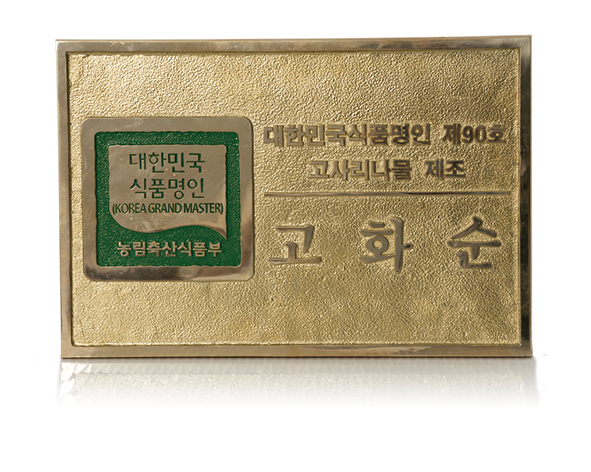
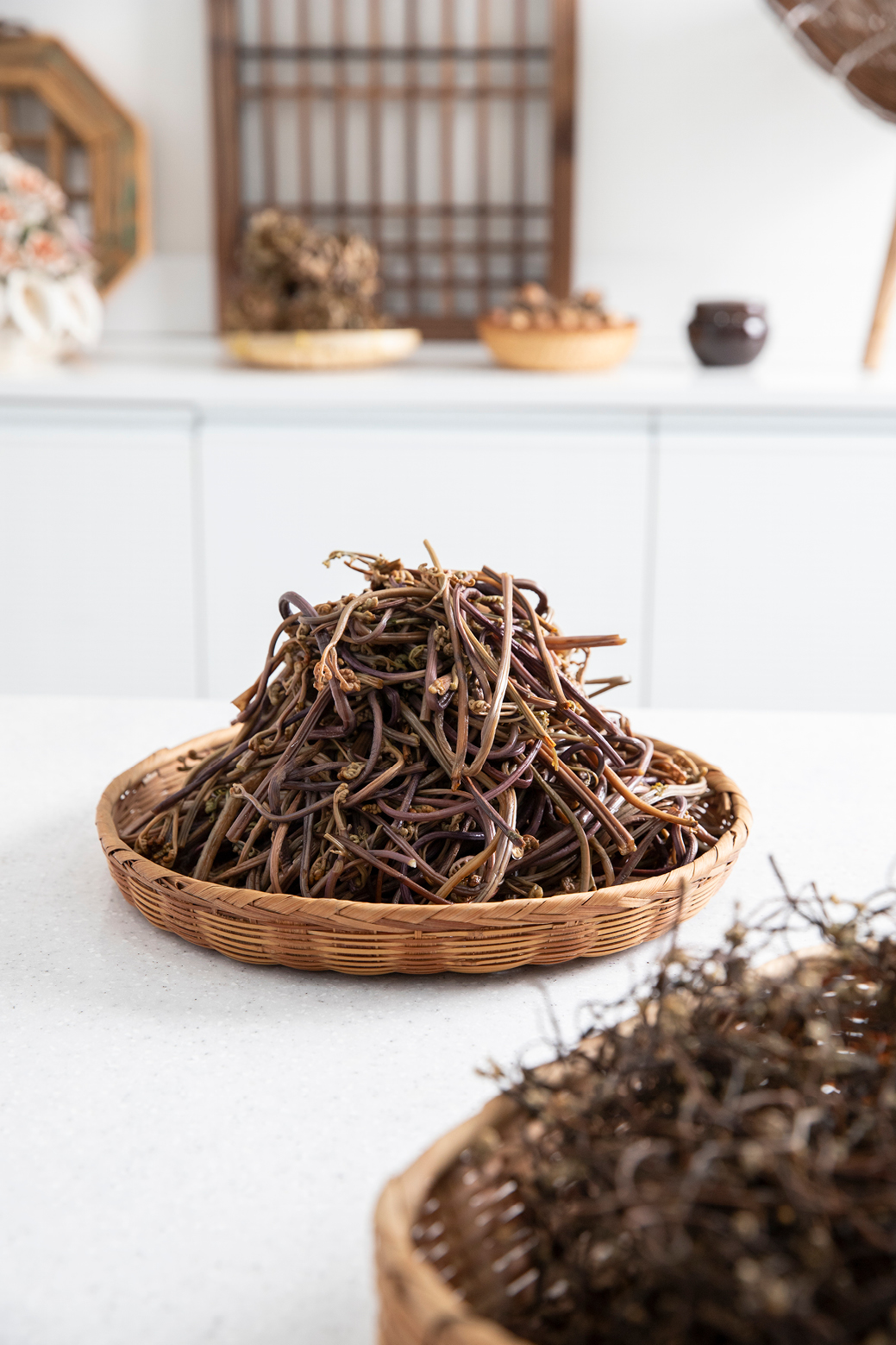
Q. Namul is an indispensable side dish in a Korean table setting. In addition to daily food, are there any customs that show our people’s affinity to namul?
Namul include sookchae made by cooking seasonal greens grown in the mountains and in the fields, and saengchae made with raw greens. Our people did not just eat it in season, but they dried wild greens in various ways and stored them as muknamul(mugeunnamul: dried greens) to soak and cook them during the winter when food ingredients were scarce. It was mainly eaten as a basic side dish in Korean food, but it was also used with rice or soup, and enjoyed it as a dessert. Korea is mostly mountainous, and namul with various textures and nutrients could be collected each season, thus nurturing the namul culture. As people grow closer to namul, it is also a dish that has to be included in ancestral rites, in addition to being eaten as a daily food. The three-color namul dish has a different meaning for each color. Bellflower root, the root, symbolizes the ancestors; bracken, the stem, symbolizes my parents and myself; and spinach, the leaves, symbolizes the children. We have a long-standing custom of eating nine types of mugeunnamul, including bracken on Jeongwol Daeboreum(the first full moon day of the new year), one of the solar terms that passed recently, to beat the heat of the coming summer.
Q. As far as we know, this is the first time that someone has been designated as the grand master of namul. This means that the process of designating a grand master is quite difficult. We wonder how you proved the tradition and the legitimacy necessary for the designation of grand master.
According to the Korea Grand Master designated by the Ministry of Agriculture, Food, and Rural Affairs, it is classified into soy sauce, kimchi, and liquor in the food category. However, namul is completely absent from the classification. Kimchi and namul are the representative side dishes made with vegetables in Korean food, but there has always been a question about whether or not the designation of a grand master is necessary for namul, which is a dish that is commonly found at tables. Thus, the process of proving that you are a grand master was not easy. Fortunately, in terms of tradition, 23 ancient documents, such as <Jeungbo Sallim Gyeongje>, <Gosa Sinseo>, and <Gyuhap Chongseo> contain the contents of namul, and, among them, I restored the original form by using the method described in <Sanga Yorok>, compiled in 1450. Since I was a child, my grandmother and my mother taught me how to collect bracken, boil it, dry it well, and store it as mugeunnamul, and how to preserve the texture and in-depth flavor of namul so I did not have much difficulty restoring the original form recorded in the literature. I did, however, had difficulty in the legitimacy section. I had a hard time collecting evidential materials of my grandmother who collected bracken all her life. The records at that time were not documented, and even neighbors who would testify about the life of my grandmother, who passed away long ago, did not know how to write, so I had to record their testimonials and notarize them. Here, the history of namul over 100 years spanning four generations with evidential materials from my mother, who has been handling namul, such as bracken and bellflower roots all her life, following my grandmother; myself, who has been working close to namul for 23 years(as of last year, when she was appointed as a grand master); and my daughter, who graduated from the Department of Food and Nutrition and continues the value of our namul, proved the legitimacy.
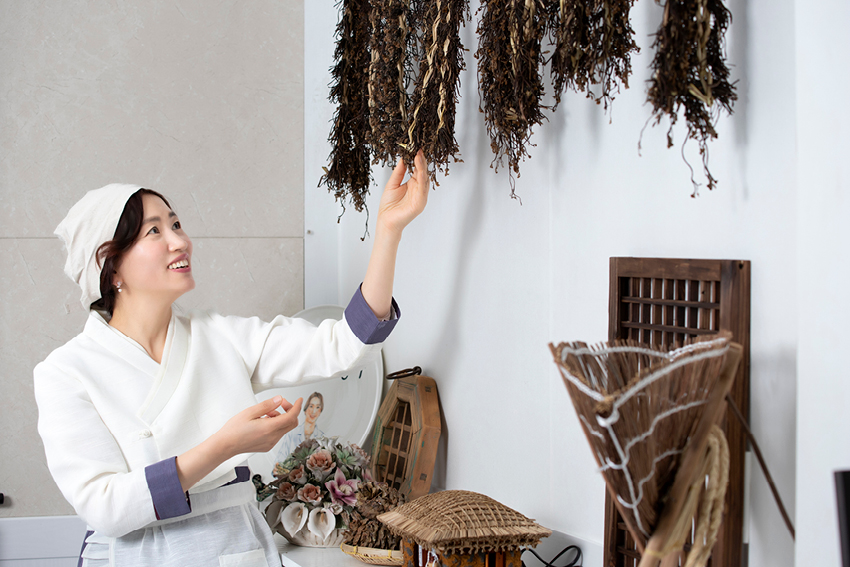
Q. You are continuing the history of 100 years by restoring the cooking method of bracken that was passed down orally through your grandmother and your mother, and passing it on to your daughter. What does bracken namul mean to you, and what motivated you to become more interested in it?
From my grandmother, my mother, me, and my daughter, bracken has been our family's food, and a valuable source of income for over 100 years. My grandmother collected and dried bracken for her family, made bracken namul to support her family, and used it as winter food for her family throughout her lifetime. Growing up with my grandmother when I was young, I also participated in the process of making bracken namul. My mother collected and dried bracken in the spring, and then sold them, and she also farmed bellflowers, so namul has always been an important part of my home.
I, who had helped my grandmother and my mother by being the breadwinner of the family with namul, started to become closer to namul when imported agriproducts came in when Korea joined the World Trade Organization(WTO) in 1995. At the time, I worked for a food ingredient company that supplied products for school lunches, and when my mother’s products, such as bellflower and bracken, took a direct hit, I started running my own business so that we could supply our namul to school lunches. In the process, while researching and studying how to make better quality Korean namul, I came to acquire the craftmanship for traditional mugeunnamul, such as eggplant, gourd, bellflower root, zucchini, wild aster, thistle, in addition to bracken. Among them, I applied to become a grand master of bracken namul, which I am related to the oldest and most closely, and was designated as such, making my relationship with namul closer and stronger.
Q. As the grand master of bracken namul, please tell us the nutritional value of bracken.
In Uljin, North Gyeongsang Province, where I was born and raised, bracken was used in many different ways. In addition to the three-colored namul, bracken was also served on ancestral rites tables by being covered with soybean powder, and boiled with radish and bean sprouts. It was also always present in bibimbap. The wisdom of our ancestors recognized early on that it is rich in protein, which is rare for namul, thus, it is called “beef collected from the mountains.” Moreover, bracken contains plenty of fiber, which is excellent for addressing constipation, and is also rich in calcium, which makes bones strong. At one time, it was reported that cattle from a foreign ranch ate bracken nearby and died of cancer, and bracken was falsely identified as a carcinogenic food that was harmful to the body. Bracken contains group 3 carcinogens called ptaquiloside, but it is only a small amount that does not affect the human body, unless it is intensively consumed for several months. Above all, there is a thesis result from the Gwangju Research Institute of Public Health and Environment that harmful ingredients such as ptaquiloside and thiaminase that destroy vitamin B1 contained in bracken are decomposed by boiling bracken and soaking it in water for more than 12 hours by changing the water about four times, so you can feel at ease.
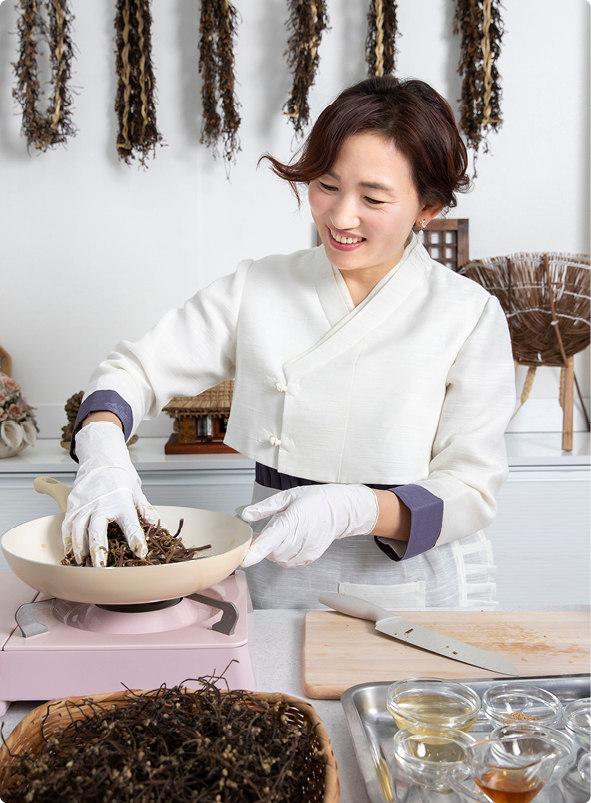
Q. Based on the cooking method of bracken namul that you restore, please tell us how to collect, blanch, and dry bracken, and how to remove the dry smell and create a good texture and deep flavor.
When collecting bracken that sprouted in the mountains and in the fields in the early spring, cut them at a distance of 3-4 cm from the ground to avoid getting a hard texture when eating it later. When blanching it, don’t overdo it, keeping in mind that you will blanch it again later. It is best to take it out and dry it when the lower part of the stem is about half-cooked. After a couple of hours, turn it over and dry it to preserve the bracken fiddleheads. When storing well-dried bracken, it is better to keep it in the refrigerator as it may smell differently if left at room temperature. To eat, soak it in the rice water overnight and then blanch it in the rice water. When blanching it, add a bowl of cold water, lower the heat, and let it settle to let it become softer. Later, after changing the water about three times to completely remove the smell, you will be able to enjoy the original flavor of bracken namul as if it is freshly collected.
Q. If you have any tips for cooking bracken that are easier and more delicious for modern people leading busy lives, please discuss them.
In reality, it takes plenty of time and effort to make a side dish by soaking and blanching mugeunnamul. Fortunately, there are many soaked and blanched bracken commercially available on the market, so you can use them to make more convenient namul side dishes.
The younger generation can incorporate it into pasta or salad according to their palate, but gosari jeon(pan-fried battered bracken), which can be served as a common side dish or side dish for liquor, is also a delicacy. Cut the blanched and dehydrated bracken into 2-cm pieces, add soy sauce, perilla oil, and garlic, mix and set aside for a while, then mix with pancake flour and egg and pan-fry it. If you add roasted beef to it, its texture and nutritional content will be much better. Adding chili pepper and chopped green onion makes the color even brighter.
Q. After being designated as a grand master, your sense of responsibility and vocation for our namul, including bracken, must have increased with the sense of pride. Please tell us about your future plans and wishes.
When I heard the news that I was designated as a grand master, I felt like I had overcome one obstacle. Personally, I felt proud that I was filial to my grandmother and my mother, who supported my family with namul all their lives. The weighty title of being the youngest and the first grand master in the namul field made me go for a grander goal. It is my new dream to properly inherit the preservation value of our namul, and contribute to promoting it not only in Korea but also around the world. I will expand the export market for namul, thanks to the K-food boom to globalize our namul, and ultimately strive to register it as a UNESCO intangible cultural heritage.
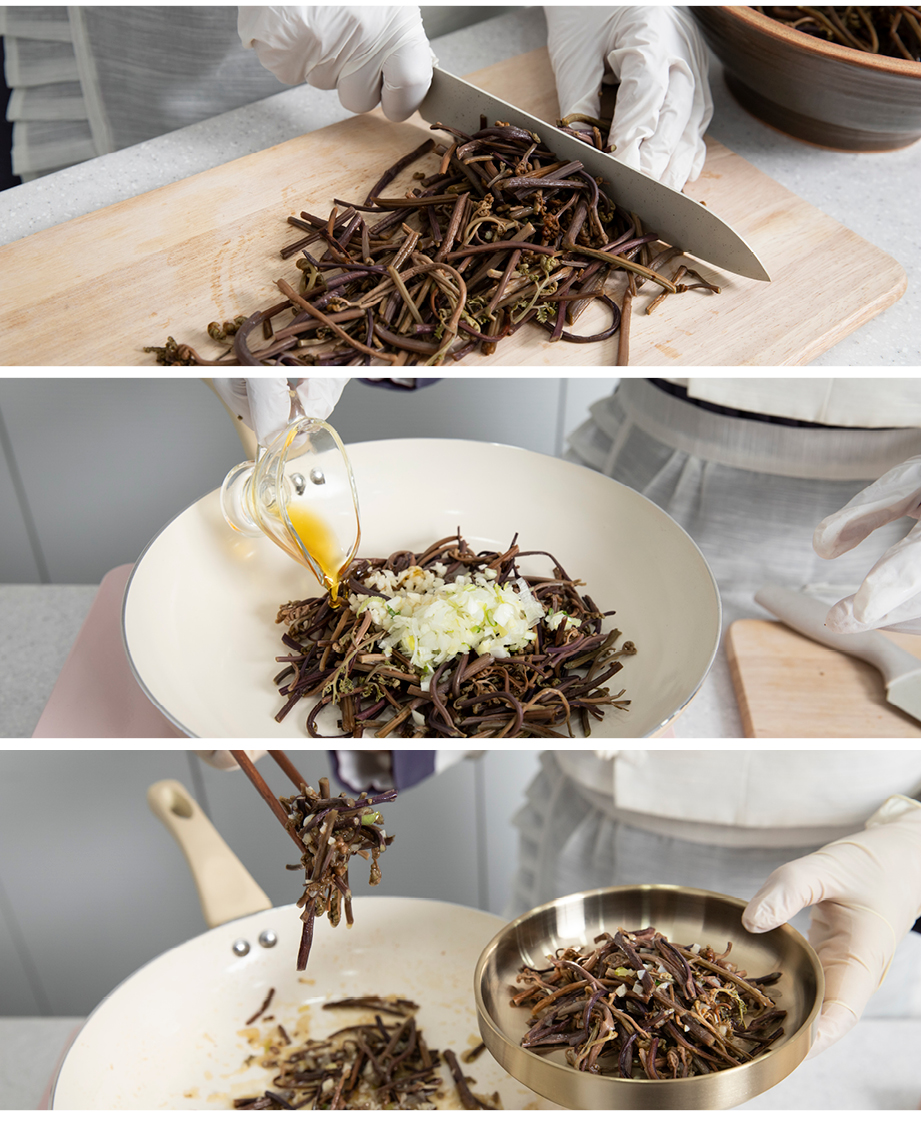
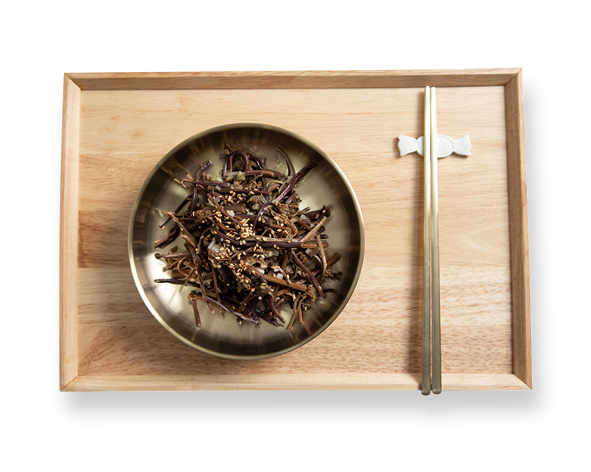
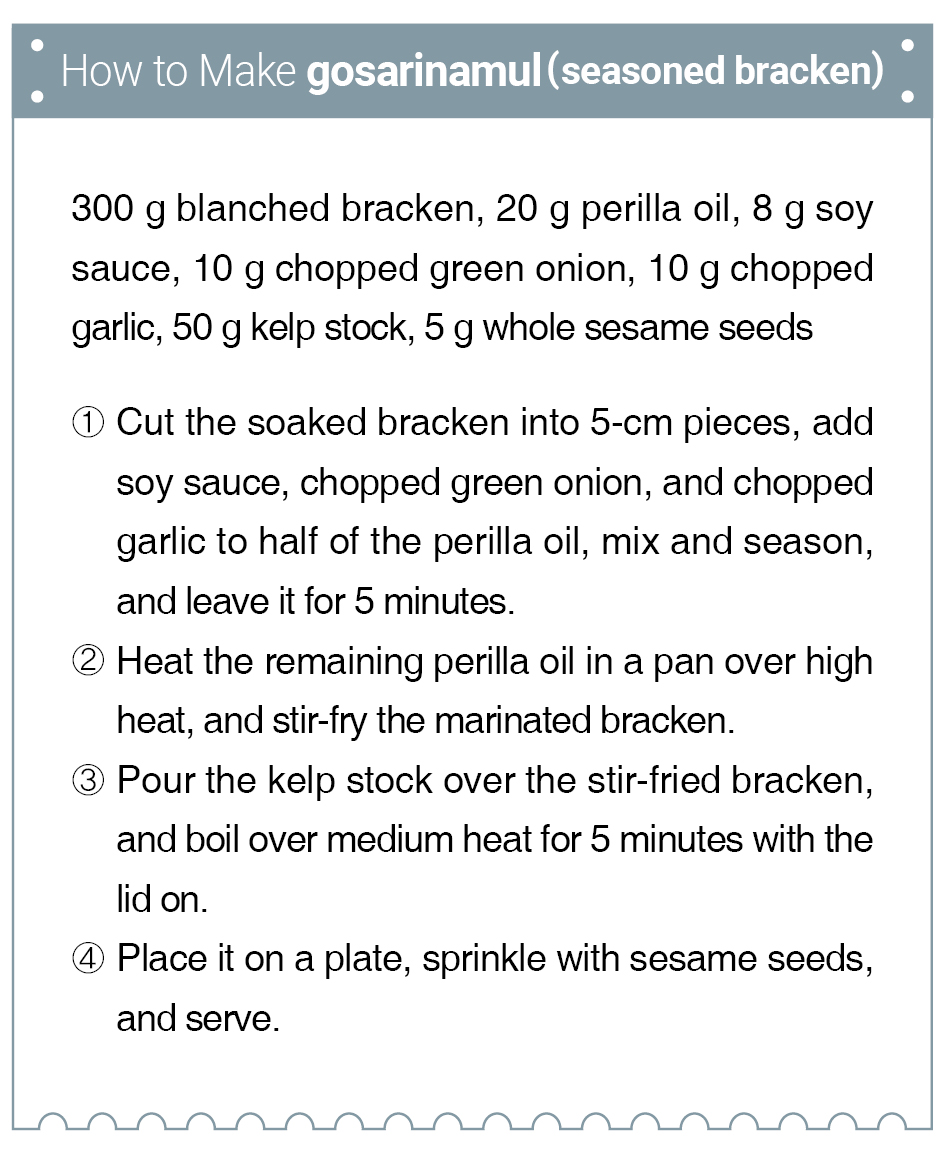

 한국어
한국어
 English
English






